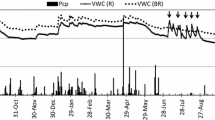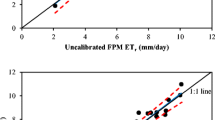Abstract
Analysing alternative methods for estimating reference evapotranspiration (ET0) is essential for improving the management of water resources, especially where meteorological data are not fully available for application of the standard Penman–Monteith (PM) method. In this study, the aim was (a) to propose a model for estimating ET0 and (b) to investigate its application together with alternative methods in an area of fruit production in the semi-arid region of Brazil. The Souza-Silva model was generated to estimate ET0 and together with other original methods based on thermal-water variables and global incident solar radiation was tested relative to the PM method. The Souza-Silva method (ET0SS = − 0.00728 + 1.356325DPV + 0.174658Qg, where VPD is the water vapour-pressure deficit and Qg the global incident solar radiation) showed excellent performance in estimating ET0 with a low level of error (RMSE = 0.467 mm day−1 and MBE = − 0.034 mm day−1). Among the original alternative methods, those for Hargreaves (ET0HS) and Camargo (ET0C) models did not perform well in the region under study. The Benevides and Lopes (ET0BL) and Valiantzas1 (ET0V1) methods gave excellent results; these were however even lower than methods based on the solar radiation. Compared to each of the original methods, the result of the Souza-Silva method showed greater precision and accuracy, with smaller estimation errors. It is concluded that this method, based on the water vapour-pressure deficit and solar radiation, can be used to estimate ET0 in places where data collection is limited.


Similar content being viewed by others
Data Availability
Not applicable.
Code availability
Not applicable.
References
Agência Nacional das Águas - ANA. Atlas irrigação. Uso da água na agricultura irrigada. Disponível em: http://atlasirrigacao.ana.gov.br. Acesso em 20 de abril de 2020.
Ahooghalandari M, Khiadani M, Jahromi ME (2016) Calibration of Valiantzas’ reference evapotranspiration equations for the Pilbara region, Western Australia. Theor Appl Climatol 128:845–856. https://doi.org/10.1007/s00704-016-1744-7
Allen RG, Pereira LS, Raes D, Smith M (1998) Crop evapotranspiration – guidelines for computing crop water requirements. Rome: FAO. (Irrigation and Dranaige, Paper 56)
Alvares CA, Stape JL, Sentelhas PC, Golçalves JLM, Sparovek G (2013) Köppen’s climate classification map for Brasil. Meteorol Z 22:711–728
Benevides JG, Lopez Diaz J (1970) Formula para el calculo de La evapotranspiracion potencial adaptada al tropico (15º N - 15º S). Agron Trop 20:335–345
Berengena J, Gavilán P (2005) Reference evapotranspiration estimation in a highly advective semiarid environment. J Irrig Drain Eng 131:147–163. https://doi.org/10.1061/(ASCE)0733-9437(2005)131:2(147)
Camargo ÂP, Sentelhas PC (1997) Avaliação do desempenho de diferentes métodos de estimativa da evapotranspiração potencial no estado de São Paulo, Brasil. Revista Brasileira De Agrometeorologia 5:89–97
Cerro RTG, Subathra MSP, Kumar NM, Verrastro S, George TGS (2020) Modelling the daily reference evapotranspiration in semi-arid region of South India: a case study comparing ANFIS and empirical models. Information Processing in Agriculture. https://doi.org/10.1016/j.inpa.2020.02.003
Chen R, Ersi K, Yang J, Lu S, Zhao W (2004) Validation of five global radiation models with measured daily data in China. Energy Convers Manage 45(11–12):1759–1769. https://doi.org/10.1016/j.enconman.2003.09.019
de Camargo AP (1971) Balanço hídrico no Estado de São Paulo. 3.ed. Campinas: IAC. (Boletim Técnico, 116)
Djaman K, O’neill M, Diop L, Bodian A, Allen S, Koudahe K, Lombard K (2019) Evaluation of the Penman-Monteith and other 34 reference evapotranspiration equations under limited data in a semiarid dry climate. Theor Appl Climatol 137:729–743. https://doi.org/10.1007/s00704-018-2624-0
Doorenbos J, Pruitt JO (1977) Guidelines for predicting crop water requirements. FAO Irrigation and Drainage 24. FAO: Roma
Gao F, Feng G, Ouyang Y, Wang H, Fisher D, Adeli A, Jenkins J (2017) Evaluation of reference evapotranspiration methods in arid, semiarid, and humid regions. J Am Water Resour Assoc 53:791–808
George BA, Reddy BRS, Raghuwanshi NS, Wallender WW (2002) Decision support system for estimating reference. J Irrig Drain Eng 128:1–10. https://doi.org/10.1061/(ASCE)0733-9437(2002)128:1(1)
Hargreaves GH, Samani ZA (1985) Reference crop evapotranspiration from temperature. J Appl Eng Agric 1:96–99
Hassan GE, Youssef ME, Mohamed ZE, Ali MA, Hanafy AA (2016) New temperature-based models for predicting global solar radiation. Appl Energy 179:437–450. https://doi.org/10.1016/j.apenergy.2016.07.006
Heydari MM, Heydari M (2014) Calibration of Hargreaves-Samani equation for estimating reference evapotranspiration in semiarid and arid regions. Archives of Agronomy and Soil Science 60(695–713):2014. https://doi.org/10.1080/03650340.2013.808740
Instituto Brasileiro de Geografia e Estatística - IBGE. Dados Econômicos. Disponível em: https://www.ibge.gov.br. Acessado em 26 de dezembro de 2020.
Irmak S, Irmak A, Allen RG, Jones JW (2003) Solar and net radiation-based equations to estimate reference evapotranspiration in humid climates. J Irrig Drain Eng 29:336–347. https://doi.org/10.1061/(ASCE)0733-9437(2003)129:5(336)
Irmak S, Payero JO, Martin DL, Irmak A, Howell TA (2006) Sensitivity analyses and sensitivity coefficients of standardized daily ASCE-Penman-Monteith equation. J Irrig Drain Eng 132:564–578. https://doi.org/10.1061/(ASCE)0733-9437(2006)132:6(564)
Jensen ME, Haise HR (1963) Estimating evapotranspiration from solar radiation. J Irrig Drain Div 89:15–41
Jerszurki D, Souza JLM, Silva LCR (2017) Expanding the geography of evapotranspiration: an improved method to quantify land-to-air water fluxes in tropical and subtropical regions. PLoS ONE 12:e0180055. https://doi.org/10.1371/journal.pone.0180055
Jerszurki D, Souza JLM, Silva LCR (2019) Sensitivity of ASCE-Penman–Monteith reference evapotranspiration under different climate types in Brazil. Clim Dyn 53:943–956. https://doi.org/10.1007/s00382-019-04619-1
Lobit P, Tagle AG, Bautista F, Lhomme JP (2017) Retrieving air humidity, global solar radiation, and reference evapotranspiration from daily temperatures: development and validation of new methods for Mexico. Part III: reference evapotranspiration. Theoret Appl Climatol 133:787–797. https://doi.org/10.1007/s00704-017-2213-7
Makkink GF (1957) Ekzamento de la formulo de Penman. Neth J Agric Sci 5:290–305
Mohammad B, Mehdizadeh S (2020) Modeling daily reference evapotranspiration via a novel approach based on support vector regression coupled with whale optimization algorithm. Agric Water Manag, 237: 106145. https://doi.org/10.26848/rbgf.v8.6.p1644-1660
Morais JEF, Silva TGF, Souza LSB, Moura MSB, Diniz WJS, Souza CAA (2015) Avaliação do método de Penman Monteith FAO 56 com dados faltosos e de métodos alternativos na estimativa da evapotranspiração de referência no Submédio Vale do São Francisco. Revista Brasileira De Geografia Física 8:1644–1660
National Institute of Meteorology – INMET. Banco de dados meteorológicos. Disponível em: https://bdmep.inmet.gov.br. Acesso em 04 de abril de 2022.
National Institute of Space Research - INPE. National Environmental Data Organization System. Disponível em: http://sonda.ccst.inpe.br/infos/index.html. Acesso em 04 de abril de 2022.
Novick KA, Ficklin DL, Stoy PC, Williams CA, Bohrer G, Oishi AC, Papuga SA, Blanken PD, Noormets A, Sulman BN, Scott RL, Wang L, Phillips RP (2016) The increasing importance of atmospheric demand for ecosystem water and carbon fluxes. Nat Clim Chang 6:1023–1027. https://doi.org/10.1038/nclimate3114
Pereira AR, Angelocci LR, Sentelhas PC (2002) Agrometeorologia: fundamentos e aplicações práticas. Porto Alegre: Guaíba Agropecuária
Porfirio ACS, Ceballos JC, Britto JMS, Costa SMS (2020) Evaluation of global solar irradiance estimates from GL1.2 satellite-based model over Brazil using an extended radiometric network. Remote Sens 12(8):1331. https://doi.org/10.3390/rs12081331
Santos RDS, Souza MHC, Bispo RC, Ventura KM, Bassoi LH (2017) Comparação entre métodos de estimativa da evapotranspiração de referência para o município de Petrolina, PE. Irriga, 1: 31–39. https://doi.org/10.15809/irriga.2017v1n1p31-39
Silva TGF, Moura MSB, Zolnier S, Soares JM, Vieira VJS, Farias Júnior WG (2011) Demanda hídrica e eficiência do uso de água da cana-de-açúcar irrigada no semiárido brasileiro. Revista Brasileira De Engenharia Agrícola e Ambiental 15:1257–1265. https://doi.org/10.1590/S1415-43662011001200007
Silva TGF, Moura MSB, Zolnier S, Soares JM, Vieira VJS, Farias Júnior WG (2012a) Requerimento hídrico e coeficiente de cultura da cana-de-açúcar irrigada no semiárido brasileiro. Revista Brasileira De Engenharia Agrícola e Ambiental 16:64–71. https://doi.org/10.1590/S1415-43662012000100009
Silva TGF, Zolnier S, Moura MSB, Carmo JFA, Ribeiro A (2012b) Fator de desacoplamento em um canavial irrigado no Submédio do Vale do São Francisco. Revista Brasileira De Engenharia Agrícola e Ambiental 16:849–858. https://doi.org/10.1590/S1415-43662012000800006
Silva TGF, Zolnier S, Moura MSB, Souza LSB (2013) Sazonalidade do Controle de Evapotranspiração pela cana-de-açúcar irrigada e características aerodinâmicas da cultura no Semiárido brasileiro. Revista Brasileira De Geografia Física 6:621–634
Souza LSB, Moura MSB, Sediyama GC, Silva TGF (2015) Balanço de energia e controle biofísico da evapotranspiração na Caatinga em condições de seca intensa. Pesq Agrop Brasileira 50:627–636. https://doi.org/10.1590/S0100-204X2015000800001
Tabari H, Hosseinzadeh-Talaee P (2011) Local calibration of the Hargreaves and Priestley-Taylor equations for estimating reference evapotranspiration in arid and cold climates of Iran based on the Penman-Monteith model. J Hydrol Eng 16:837–845. https://doi.org/10.1061/(ASCE)HE.1943-5584.0000366
Turc L (1961) Estimation of irrigation water requirements, potential evapotranspiration: a simple climatic formula evolved up to date. Annals of Agronomy 12:13–49. https://doi.org/10.1016/j.agwat.2020.106145.10.1111/1752-1688.12530.10.1127/0941-2948/2013/0507
Valiantzas JD (2012) Simple ET forms of Penman’s equation without wind and/or humidity data. I: theoretical development. J Irrig Drain Eng 139:1–8. https://doi.org/10.1061/(ASCE)IR.1943-4774.0000520
Valiantzas JD (2013) Simplified reference evapotranspiration formula using an empirical impact factor for Penman’s aerodynamic term. J Hydrol Eng 18:108–114. https://doi.org/10.1061/(asce)he.1943-5584.0000590
Valiantzas J (2018) Temperature-and humidity-based simplified Penman’s ET0 formulae. Comparisons with temperature-based Hargreaves-Samani and other methodologies. Agric Water Manag 208:326–334. https://doi.org/10.1016/j.agwat.2018.06.028
Willmott CJ, Ackleson SG, Davis RE (1985) Statistics for the evaluation and comparison of models. J Geophys Res 90:8995–9005
Yamashita T, Yamashita K, Kamimura R (2007) A stepwise AIC method for variable selection in linear regression. Communications in Statistics - Theory and Methods 37:2395–2403. https://doi.org/10.1080/03610920701215639
Funding
The authors would like to thank the National Council for Scientific and Technological Development (CNPq—309421/2018–7, and 152251/2018–9) for their financial support. The authors would also like to thank the Coordination for the Improvement of Higher Education Personnel (CAPES—Finance Code 001) for the research and study grants.
Author information
Authors and Affiliations
Contributions
LSBdS—formal analysis, investigation, writing—original draft. MTLS—formal analysis, investigation, writing—original draft. EA—formal analysis, writing—original draft. MSBdM—database, writing—original draft. JFdCN—writing—original draft, formal analysis. CAAdS—writing—original draft. TGFdS—formal analysis, investigation, writing—original draft.
Corresponding author
Ethics declarations
Ethics approval
Not applicable.
Consent to participate
Not applicable.
Consent for publication
Not applicable.
Competing interests
The authors declare no competing interests.
Additional information
Publisher's note
Springer Nature remains neutral with regard to jurisdictional claims in published maps and institutional affiliations.
Rights and permissions
About this article
Cite this article
de Souza, L.S.B., Silva, M., Alba, E. et al. New method for estimating reference evapotranspiration and comparison with alternative methods in a fruit-producing hub in the semi-arid region of Brazil. Theor Appl Climatol 149, 593–602 (2022). https://doi.org/10.1007/s00704-022-04069-6
Received:
Accepted:
Published:
Issue Date:
DOI: https://doi.org/10.1007/s00704-022-04069-6




